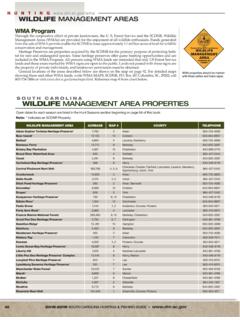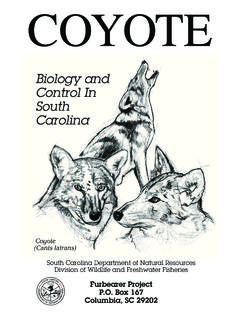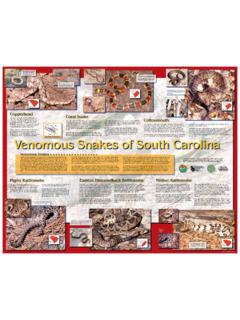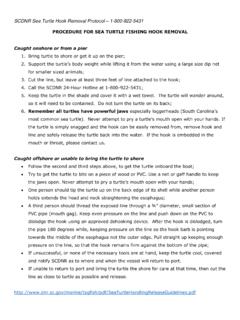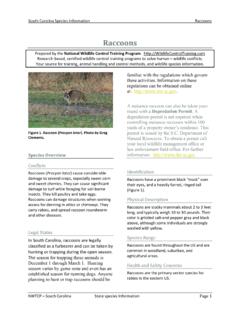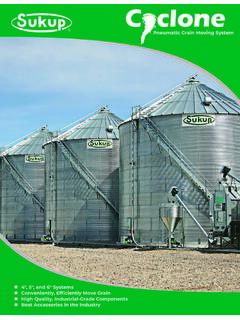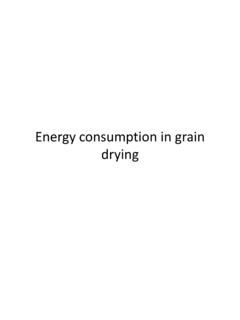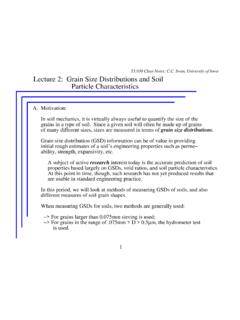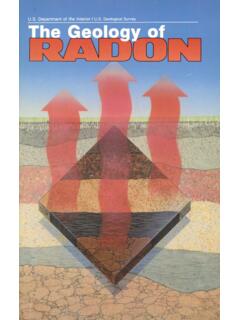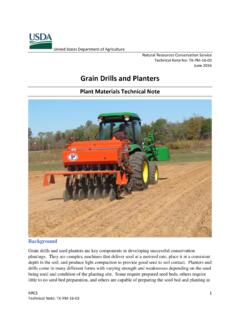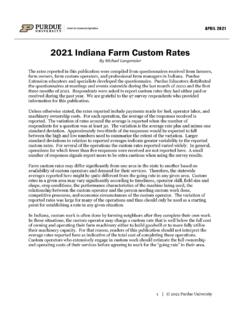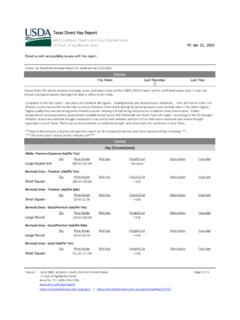Transcription of Sedimentary Rocks and the Rock Cycle
1 Sedimentary Rocks and the Rock Cycle Designed to meet South Carolina Department of Education 2005 Science Academic Standards 1. Table of Contents What are Rocks ? (slide 3). Major Rock Types (slide 4) (standard ). The Rock Cycle (slide 5). Sedimentary Rocks (slide 6). Diagenesis (slide 7). Naming and Classifying Sedimentary Rocks (slide 8). Texture: grain Size (slide 9), Sorting (slide 10) , and Rounding (slide 11). Texture and Weathering (slide 12). Field Identification (slide 13). Classifying Sedimentary Rocks (slide 14). Sedimentary Rocks : (slide 15). Clastic Sedimentary Rocks : Sandstone (16) , Siltstone (17), Shale (18), Mudstone (19) , Conglomerate (20), Breccia (21) , and Kaolin (22). Chemical Inorganic Sedimentary Rocks : Dolostone (23) and Evaporites (24). Chemical / Biochemical Sedimentary Rocks : Limestone (25) , Coral Reefs (26), Coquina and Chalk (27), Travertine (28) and Oolite (29).
2 Chemical Organic Sedimentary Rocks : Coal (30), Chert (31): Flint, Jasper and Agate (32). Stratigraphy (slide 33) and Sedimentary Structures (slide 34 ). Sedimentary Rocks in South Carolina (slide 35). Sedimentary Rocks in the Landscape (slide 36). South Carolina Science Standards (slide 37). Resources and References (slide 38). 2. What are Rocks ? Most Rocks are an aggregate of one or more minerals and a few Rocks are composed of non-mineral matter. There are three major rock types: 1. Igneous 2. Metamorphic 3. Sedimentary 3. Table of Contents Major Rock Types Igneous Rocks are formed by the cooling of molten magma or lava near, at, or below the Earth's surface. Sedimentary Rocks are formed by the lithification of inorganic and organic sediments deposited at or near the Earth's surface. Metamorphic Rocks are formed when preexisting Rocks are transformed into new Rocks by elevated heat and pressure below the Earth's surface.
3 4. Table of Contents The Rock Cycle The Rock Cycle graphic is available from the SCGS website: 5. Table of Contents Sedimentary Rocks Sedimentary Rocks are formed by the lithification of inorganic and/or organic sediments, or as chemical precipitates. There are two types of Sedimentary Rocks : Clastic and Chemical Clastic Sedimentary Rocks form when existing parent rock material is weathered, fragmented, transported, and deposited in layers that compact, cement, and lithify to form Sedimentary Rocks . Chemical Sedimentary Rocks are formed by a variety of processes and are divided into sub-categories including inorganic, and biochemical or organic chemical Sedimentary Rocks . Inorganic chemical Rocks form from chemicals that are dissolved in a solution, transported, and chemically precipitated out of solution. Biochemical or Organic Sedimentary Rocks form when plant or animal material is deposited and lithified.
4 Those classified as biochemical chemical generally involve some form of fossilization or the accumulation of fossilized organism or organism remains, such as shell fragments. Organic Rocks that are classified as clastic, involve the deposition of plant material and formation of peat and coal deposits. The physical, chemical, or biological changes that occur during the lithification of Sedimentary Rocks are described by process collectively referred to as diagenesis. 6. Table of Contents Diagenesis Diagenesis collectively refers to the physical, chemical, and biological changes which may occur during the formation of Sedimentary Rocks . Recrystallization, compaction, cementation, and lithification, are all examples of diagenetic changes. Recrystallization occurs when unstable minerals recrystallize to form more stable minerals. Recrystallization most often occurs during the formation of chemical Sedimentary limestone Rocks that previously contained aragonite a chemically unstable form of calcium carbonate (CaCO3).
5 Compaction occurs when sediments are progressively deposited on top of one another, and over time the weight of the accumulated sediments increases and compresses the buried sediments. Continued compression of buried sediments reduces pore-spaces and removes excess water, as a result the closely packed individual grains begin to slowly compact into a solid rock. Cementation involves a chemical change whereby individual grains are cemented together as minerals are precipitated out of saturated solution that is percolating as a matrix between individual sediments. The accumulation of the precipitated minerals causes the grains to cement together. Cementation can occur in combination with the presence of other minerals, rock fragments, or organic constituents such as fossilized organisms. Lithification occurs when unconsolidated sediments are cohesively bound to form a solid Sedimentary rock.
6 Compaction and/or cementation are generally the precursor to the lithification process. 7. Table of Contents Naming and Classifying Sedimentary Rocks Geologists name and classify Sedimentary Rocks based on their mineral composition and texture Mineral composition refers to the specific minerals in the rock. For example sandstone will contain predominantly quartz, while limestone will contain mainly calcite (calcium carbonate). Texture includes the grain size and shape, sorting, and rounding of the sediments that form the rock. 8. Table of Contents Texture: grain Size grain size is used to describe the size of the individual mineral grains, rock fragments, or organic material that are cemented together to form a clastic or chemical Sedimentary rock grain Size Categories grain Size Divisions very coarse-grained > 16 mm coarse grained > 2 mm < 16 mm medium grained > mm < 2 mm fine grained > mm < mm very fine-grained > mm < mm cryptocrystalline < mm (4 m ).
7 9. Table of Contents Texture: Sorting Sorting is used to describe the grain size distribution or range of grain sizes in a rock. Poorly sorted Rocks contain a variety of different sized grains. Poorly sorted Rocks contain a wide range of grain sizes including fine, medium, and coarse. Well sorted Rocks contain almost all grains of the same size. Moderately sorted Rocks contain particles of relatively similar grain sizes. Moderately sorted Rocks may contain fine and medium grains, or medium and coarse grains. Poorly Sorted Well Sorted 10. Table of Contents Texture: Rounding Rounding is used to describe the relative shape of the grains. Classifications are describe as deviations from rounded or spheroidal grain shapes. Well rounded grains are smooth with rounded Moderately rounded grains are in-between the sharp, angular edges of a poorly rounded grain and the smooth, roundness of a well-rounded grain .
8 Poorly rounded grains may be sharp or angular. Well-rounded, Poorly rounded, spheroidal grains angular grains 11. Table of Contents Texture and Weathering The texture of a Sedimentary rock can provide a lot of information about the types of environments that the sediments were weathered in, transported by, and deposited in prior to their lithification into Sedimentary Rocks . Most Sedimentary Rocks consist of grains that weathered from a parent rock and were transported by water, wind, or ice before being deposited. grain size is a good indicator of the energy or force required to move a grain of a given size. Large sediments such as gravel, cobbles, and boulders require more energy to move than smaller sand, silt, and clay sized sediments. grain size is also an indicator of the distance or length of time the sediments may have traveled. Smaller grain sizes generally indicate greater transport distances and duration than larger grains.
9 Sorting will generally improve with the constant or persistent moving of particles, and thus can indicate if particles were transported over a long distance or for a long time period. Sorting can also indicate selective transport of a particular grain size. Rounding is a good indicator for the amount of abrasion experienced by sediments. In general, sediments that have been transported longer distances will be more rounded than those which have traveled shorter distances. An example based on these principles, is that sediments deposited by rapid mass wasting events, such as landlsides are expected to be coarse grained, poorly sorted, and poorly rounded; and sediments deposited by slower, more gradual processes, such as dune formation, are expected to be fine grained, well sorted, and well rounded. 12. Table of Contents Field Identification Geologists often use reference guides to identify and measure textural characteristics of the sediments.
10 This is an example of a card used to aid in the identification textural characteristics. A card like this may be carried in a geologist's pocket or around their neck. Front of card Back of card 13. Table of Contents Classifying Sedimentary Rocks CLASTIC Sedimentary Rocks . TEXTURE SEDIMENT PARTICLE SIZE OTHER CHARACTERISTICS Sedimentary ROCK. Rounded rock fragments, Conglomerate Poorly-sorted Gravel (> 2 mm). Angular rock fragments, Breccia Poorly-sorted Quartz (>50%), Quartz sandstone Moderate well sorted CLASTIC Quartz with Feldspar, Arkose Sand ( mm 2 mm) Moderate Well sorted Quartz, Feldspar, Clays, Rocky Graywacke Fragments, Well-sorted Mud (< mm) Fine, thin layers, or cohesive clumps, Shale, Siltstone, and Well-sorted Mudstone CHEMICAL Sedimentary Rocks (INORGANIC AND BIOCHEMICAL). GROUP TEXTURE CHEMICAL COMPOSITION Sedimentary ROCK. clastic or non-clastic Calcite, CaCO3 Limestone non-clastic Dolomite, CaMg(CO3)2 Dolostone INORGANIC non-clastic Microcrystalline quartz, SiO2 Chert non-clastic Halite, NaCl Rock salt non-clastic Gypsum, CaSO4 2H20 Rock Gypsum clastic or non-clastic Calcite CaCO3 Limestone BIOCHEMICAL non-clastic Microcrystalline quartz, SiO2 Chert non-clastic Altered plant remains Coal 14.

